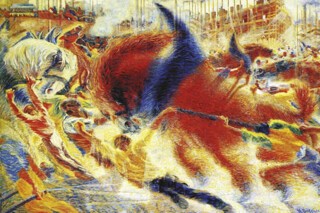The Italian futurists were hell-bent on modernity, largely because Italy was late to industrialise. Led by the strident Marinetti, these artists, architects, photographers, writers and composers were the self-appointed shock troops of the new. They were ready, rhetorically at least, to ditch traditional culture, calling for museums to be set ablaze and Venice to be paved over, and disdained liberal institutions, railing against the vagaries of parliamentary democracy in particular. In the midst of these rants against bourgeois ‘decadence’, the futurists found time to disparage women (if femininity was horrible, feminism was unspeakable) and to celebrate war (‘the world’s only hygiene’, Marinetti liked to call it). In this same line they advocated a macho nationalism that was both irredentist and imperialist, agitating in support of the First World War, an instance of hygiene that carried some of the most talented futurists, such as the painter and sculptor Umberto Boccioni and the architect Antonio Sant’Elia, to early deaths.
A modernist movement that is both radical and reactionary is hardly an oxymoron, but it is still a problem to puzzle over, and in some ways futurism is the prototypical avant-garde of the 20th century. It raised the modernist genre of the manifesto to a histrionic pitch and pace, refashioning it in terms of mass media publicity and scandal. When Marinetti published the first futurist manifesto in 1909, it appeared not as a brochure to be passed hand to hand in backwater Milan, but on the front page of Le Figaro in Paris, capital of Europe. Marinetti also cut a new figure for the avant-gardist, no longer the Baudelairean bohemian of melancholy and spleen but the super-animated impresario on an international tour of outlandish performances calculated to provoke artistic outrage and newspaper coverage. This kind of spectacle left its mark not only on other artistic movements, such as the Dada of Tristan Tzara, but also on new mass parties, above all Mussolini’s Fascists, and in some respects it is still with us.
Futurism wasn’t all bravado; it did have an aesthetic (or anti-aesthetic) of its own, which was to modernise the arts through a mimicry of the effects of new media, such as the adaptation of chronophotography and cinema to painting, photography and sculpture, or the application of the phonograph to musical performance. More ambitiously, the futurists sought to refashion the human sensorium along the lines of these new techniques of perception, and to this end they updated the ideas of synaesthesia, or the fusion of the senses, and kinaesthesia, or the mixing of bodies in motion and at rest. At the same time (and this is just one of many contradictions), the futurists were conservative stylistically; for all their nationalist pride, they relied on French sources, especially the divisionist brushstroke of neo-impressionist painting, which they adapted to themes of the modern city. Thus in Street Light (1909) Giacomo Balla offers the streetlamp as an improvement on the moon: both kinds of illumination are represented as waves of energy, but the artificial light dominates the natural one. So too in The City Rises (1910-11) Boccioni shows us the metropolis as a firestorm of colour greater than any in nature, where construction is difficult to distinguish from destruction; here the futurists thrill to modernity as catastrophe.
At the time of these canvases Balla and Boccioni were with Marinetti in Paris, where they encountered early examples of cubist painting, the fractured composition of which they also adapted to futurist subjects of speed and force. Little interested in its structure or its semiotics, they used cubism simply as a device to evoke the blurring of things in motion. Boccioni explores kinaesthetic interpenetration in sculpture too, as in Unique Forms of Continuity in Space (1913). ‘Let’s split open our figures and place the environment inside them,’ he writes in ‘Technical Manifesto of Futurist Sculpture’ (1912). ‘We declare that the environment must form part of the plastic whole, a world of its own, with its own laws: so that the pavement can jump up onto your table, or your head can cross a street, while your lamp twines a web of plaster rays from one house to the next.’
How can static arts like painting and sculpture express movement and mélange in this way? The futurists might have preferred a speeding car to the Winged Victory of Samothrace, but Unique Forms of Continuity in Space is far closer to the latter than the former. And architecture proved more recalcitrant still: the drawings for a Città Nuova by Sant’Elia adapt futurist lines of force to the vertical massing of infrastructural buildings, but the impressive results are also often oppressive, even deadly, in their monumentality. Futurist photography, with its multiple exposures, was better suited to the desired dynamism, yet this work remained a sideshow. Only the parole in libertà (‘words in freedom’), broken into letters and scattered over the page, approach the intended effect, but these expressions of city sirens, military explosions and human shrieks are frequently onomatopoeic, more directly referential of noise in the world than liberated from it; and others like Hugo Ball, Kurt Schwitters and Aleksei Kruchenykh advanced this line of linguistic invention more radically than Marinetti and company in any case.
The assault on language was nonetheless central to the attack on the bourgeois subject, which is what interested Gramsci in futurism. Marinetti excoriated subjectivity understood as interiority (‘destroy the I,’ he exclaims in one manifesto, ‘that is, all psychology’), pitting technological shock against ‘the old syntax’ of the self and calling on futurist art and writing to harden bodies and psyches alike. In one text Marinetti exhorts futurists to ‘dehumanise’ the voice, to ‘metalise’ the face, to ‘pistonise’ the body; in another he offers the merging of aviator into plane as an exemplum of this Lamarckian makeover. In short, for Marinetti the futurist subject is to accelerate the prosthetic evolution of the human species, for only then might the new man of modernity ‘be endowed with surprising organs, organs adapted to the needs of a world of ceaseless shocks’. This is the double movement of his strange thought: at once to reify the body and to vitalise things, ‘to substitute for human psychology, now exhausted, the lyric obsession with matter’. It is as though the only way to survive, indeed to thrive, in military-industrial modernity was to push this process of reification further: on the one hand, to extrapolate the human towards the inorganic-technological, on the other, to make the inorganic-technological the epitome of the human; on the one hand to be already dead, on the other to stake the future of life on technology.
For Marinetti the futurist must not only submit to this technological extrapolation but also embrace it. In this respect the futurist subject is the fascist subject. ‘I owe most to Georges Sorel,’ Mussolini once remarked, and Marinetti was also indebted to the French syndicalist, whose Reflections on Violence was published in 1908, a year before the founding of futurism. Sorel espoused a ‘catastrophic conception of socialism’ in which social crisis might be recouped as political revolution through a violent event, such as a general strike, that could be represented as a foundational myth, replete with dramatic images, of the new order to come; such ‘a myth cannot be refuted,’ Sorel argued, for it represents ‘convictions in the language of movement’. Marinetti elaborated on this playbook in his manifestos, and Mussolini performed it in his March on Rome in 1922.
This is one lesson of futurism, and it was articulated as such by Walter Benjamin at the end of his essay ‘The Work of Art in the Age of Technical Reproducibility’ (1936): with Marinetti and company, Benjamin writes, ‘self-alienation has reached such a degree’ that mankind ‘can experience its own destruction as an aesthetic pleasure of the first order’. It is a lesson not foregrounded in Italian Futurism, 1909-44: Reconstructing the Universe at the Guggenheim in New York (until 1 September), a generous survey of roughly 360 pieces by some eighty artists, which ranges widely across futurist production from the founding manifesto to the death of Marinetti, including much work that is rarely seen. The exhibition does make the connection to Fascism (at this point it can’t be avoided), but sidesteps the turn to reactionary figuration on the part of many futurists in the 1920s in order to trace a second generation, who were still producing work well into the Second World War. Perhaps the greatest revelation is Benedetta Cappa, a rare woman in the group (she was married to Marinetti), who produced the five large murals on the theme of modern communications (for a Palermo post office in 1933-34) which conclude the show. The title of the exhibition, Reconstructing the Universe, sounds an ominous note here, for these paintings, with aerial perspectives that tend to the heavenly, aim to pictorialise absolute mastery over the world.
Other ambitions of futurism are more innocuous in outcome. Often in the second generation its technophilia decayed into a bland version of Art Deco, and its dream of a technological Gesamtkunstwerk faded into a hokey genre of theatrical spectacle. And then there is its love affair, first and last, with publicity. As Fortunato Depero, a talented jack-of-all-arts who designed ads for Campari, wrote in 1931, ‘the art of the future will … be the art of advertising.’ Art that becomes Deco or advertising, that is an expression of a will to power or of destruction experienced as ‘an aesthetic pleasure of the first order’: futurism is almost enough to cure you of the future.
Send Letters To:
The Editor
London Review of Books,
28 Little Russell Street
London, WC1A 2HN
letters@lrb.co.uk
Please include name, address, and a telephone number.


